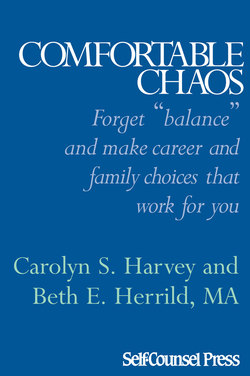Читать книгу Comfortable Chaos - Carolyn Harvey & Beth Herrild - Страница 22
На сайте Литреса книга снята с продажи.
Recognizing the Warning Signs before Capsizing
ОглавлениеIt’s very easy to get caught up in the activity of the moment, and not notice that you are close to capsizing. Another way to think of this is learning to read the signals that you are reaching the edge of your tolerance for chaos. Again, your coefficient for chaos can play a role. High CFC people will take longer to reach their tolerance level than low CFCs, but everyone has limits and signals. High CFCs have to be a little more careful in this area because they tend to ignore the signals and push on because of the sheer excitement of what they are doing.
People have a variety of signals that let them know they are reaching the edge of their tolerance. Scott, a manager at a high-tech company and father to two elementary-aged children says, “I know I’m reaching my threshold when I start losing track of what needs to be done. Whether it’s work related or personal, I need to stop and try and get organized again. I will sit down and reprioritize my task list.”
For other people, the signs can be physical. Mark is an attorney at a telecommunications company with two small boys at home and says one of his signals is a muscle pain in his back. Mark also has nonphysical signs. “I get in a total reactive mode and am not doing anything proactive. I find myself flitting around putting out lots of little fires but not really completing anything.” This feeling of being like a hamster on a wheel, running but not actually accomplishing much, is a common response to feeling overwhelmed.
In place of feeling physical symptoms or focusing on tasks, some people show their frustration in their interactions with others. Instead of calmly answering a question they may respond abruptly or with sarcasm. Many of the people we interviewed cited “being snippy” as one of their most common reactions to surpassing their tolerance for chaos.
What are your personal signs that you are about to tip out of the raft? You may have one signal in particular or feel it on many different levels. If you are not clear what your signals are, then make an effort to observe them next time you start to get overwhelmed. Recognizing these warning signs can be a huge help because next time you notice them you can stop what you are doing and regroup. Take a five-minute break and ask yourself, “What can I do to stabilize my raft?” Try to calm yourself and step back from the situation for a few minutes. This may mean getting up from your desk and taking a walk, going to the restroom, breathing, or whatever else works for you. By shifting your focus, the next steps will seem more obvious and you can congratulate yourself on avoiding being capsized.
In this chapter, you have discovered where your time goes, where you would like it to go, and your coefficient for chaos. Understanding your own personal preferences and tolerances, all part of individual, is the critical beginning for moving along the continuum toward achieving Comfortable Chaos. In the next chapter, we shift our attention to the pressures and challenges of today’s world and learn some tools that fall under the second I, imperfect.
